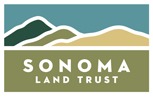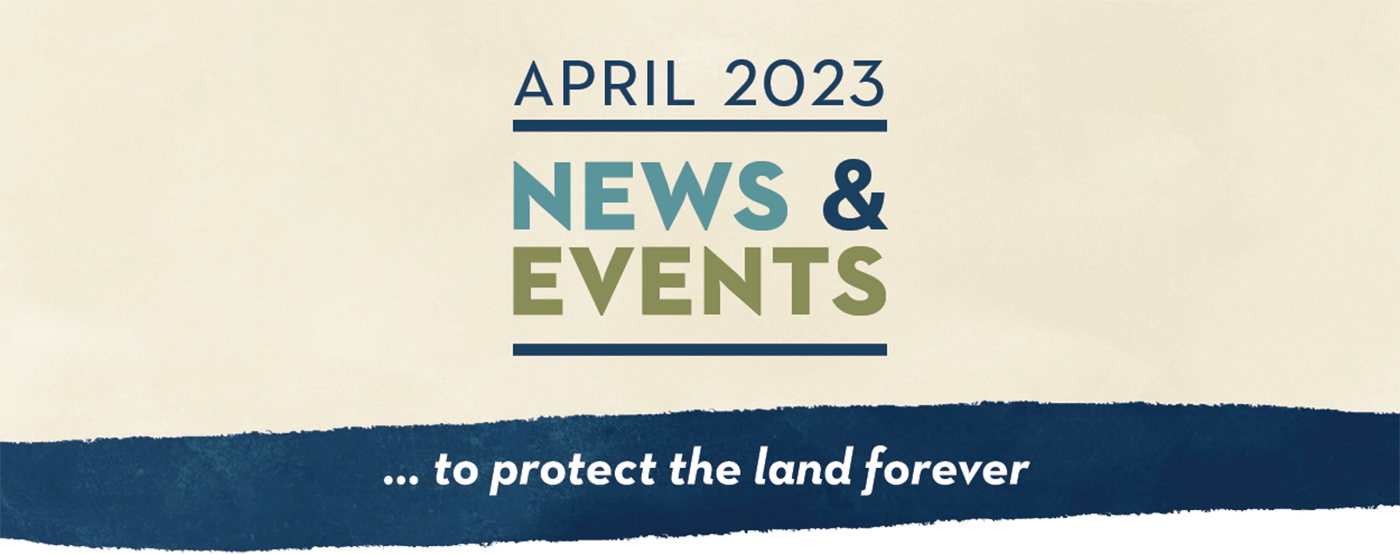
A night we won’t forget – our strategic plan charrette
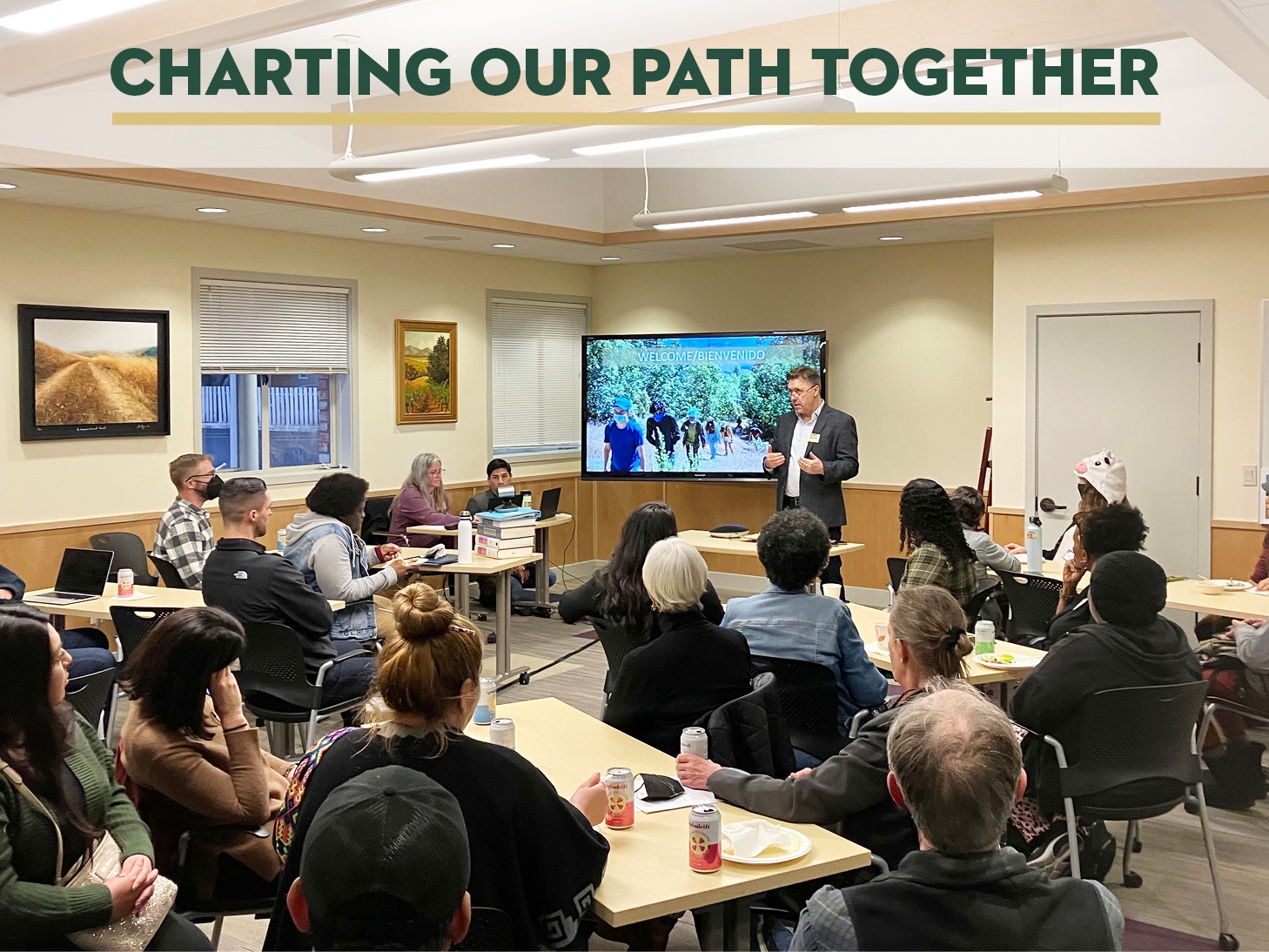
During a chilly evening in February, a select group of community members arrived at our downtown Santa Rosa office for the first indoor of its kind since the pandemic, for a hot meal, lively conversation, and problem solving. The group gathered to participate in a “charrette” (a public meeting or workshop devoted to a concerted effort to solve a problem or design a plan) to craft an updated strategic plan that will guide Sonoma Land Trust’s work over the next five years. The charrette created a dialog between key partners, community leaders, and Sonoma Land Trust staff that reviewed the draft 2023-2028 strategic plan. This exchange of ideas offered a process where our organizational goals are vetted by the community and where we captured their feedback before finalizing the plan. We learned about the issues that matter most to our community and their feedback and their support, is critical to our success.
With Sonoma County’s incredibly rich diversity of cultures, each participant’s perspective provides valuable insight into how Sonoma Land Trust’s programs can solve challenges, address climate concerns, and inform and educate everyone on the impact nature has on their health and their livelihoods.
“Nature shows up for each of us in different ways. It is critical to our work that we understand the different relationships and perspectives from our community on how nature shows up for them. The charrette provided an intimate dialogue where ideas, experiences, and values were exchanged to inform a plan that connects land conservation and restoration practices with the needs of our community. We value diverse experiences and intentionally created a space where everyone can speak up and be listened to,” said Eamon O’Byrne, executive director.
In alignment with our commitment to upholding our equity goals in everything that we do (as outlined in our Diversity, Equity, and Inclusion Plan), we invited a wide array of voices that reflect the diversity in our community across race, gender, ethnicity, culture, and geographic location. Community leaders, volunteers, landowners, tribal members, and program participants from across Sonoma County were invited to join the charrette and to our delight, they showed up and shared their stories and ideas!
Neal Ramus, the director of community engagement and education at Sonoma Land Trust lead his team in the development of this event stating that, “We are deeply committed to our community, listening to their opinions and responding to their needs around climate action and environmental justice. To ensure the charrette was accessible as possible, we offered free childcare, a warm meal, and Spanish language interpretation. In this way, we worked to limit the barriers that are common when bringing a diverse range of voices to the table.”
Attendees were invited to participate in workshop-style sessions, each focusing on different focal strategies of the plan broken into three categories (land, water, and people): land: protecting biodiversity, living with fire; water: securing freshwater flows, adapting to rising waters; people: nature nearby, and empowering communities.
Unlike other traditional formats for providing input such as polls and surveys, the charrette placed the leaders of each strategy around the table to facilitate the discussions and listen to the feedback in real time answering questions and taking notes. This created a deeper level of engagement for everyone and provided the staff and board at Sonoma Land Trust a chance to listen to the ideas, concerns, and recommendations directly in both English and in Spanish.
Gregory Appling was one of several Sonoma Land Trust Board members that participated by greeting guests and engaging in the discussions. He shared that “Supporting an organization that actually walks their talk is amazing and in keeping with the values of this incredible group. The event signaled our desire to not only bring the community in, but to amplify voices that have been historically marginalized and too often left out of the conversation altogether. I was proud to represent Sonoma Land Trust in this way.”
Though the charrette was a single evening with only a small representation of our community, the feedback was impactful and appreciated. Our staff and board listened, discussed, and integrated what was shared which ultimately produced a more robust, inclusive, and transparent strategic plan.
We are looking forward to implementing the shared goals and visions our community and are proud to be working to protect the open, natural, and working lands and waters of Sonoma County.
Look for the release of the new plan in next month’s eNews
Una noche que no olvidaremos: nuestra charrette del plan estratégico
Durante una fría tarde de febrero, los miembros de la comunidad llegaron a nuestra oficina del centro de Santa Rosa para celebrar el primer evento en interiores desde la pandemia, en el que disfrutaron de una comida caliente, una conversación dinámica y tareas de resolución de problemas. El grupo se reunió para participar en una charrette, un proceso de planificación colaborativa para elaborar un plan estratégico actualizado que guiará el trabajo de Sonoma Land Trust durante los próximos cinco años. La charrette se diseñó para generar el diálogo entre los socios clave, los líderes de la comunidad y el personal de Sonoma Land Trust con respecto al borrador del plan estratégico 2023-2028. Este intercambio de comentarios es un proceso esencial que garantiza que los objetivos que establezcamos juntos alineen nuestra misión con los asuntos que más le importan a nuestra comunidad, mediante un proceso transparente e inclusivo.
Con la diversidad de culturas increíblemente rica que tiene el condado de Sonoma, y la amplia gama de experiencias que todos tienen con la naturaleza, la perspectiva de cada persona proporciona una valiosa visión acerca de la forma en la cual los programas de Sonoma Land Trust pueden resolver desafíos, abordar problemas climáticos e informar y educar a todos sobre el impacto que la naturaleza tiene sobre la salud y el sustento.
“La naturaleza se muestra ante cada uno de nosotros de formas diferentes. Es fundamental para nuestro trabajo que comprendamos las distintas relaciones y perspectivas de los miembros de nuestra comunidad sobre cómo perciben la naturaleza. La charrette propició un diálogo profundo en el que se intercambiaron ideas, experiencias y valores para elaborar un plan que conecte las prácticas de conservación y restauración de la tierra con las necesidades de nuestra comunidad. Valoramos las experiencias diversas y creamos intencionalmente un espacio en el que todos pudieran hablar y ser escuchados.” –Eamon O’Byrne, Director Ejecutivo
En consonancia con nuestro compromiso de mantener nuestros objetivos de equidad en todo lo que hacemos (como se indica en nuestro Plan de Diversidad, Equidad e Inclusión), invitamos a una gran variedad de voces que reflejan la diversidad de nuestra comunidad en aspectos demográficos como: la raza, el género, el origen étnico, la cultura y la ubicación geográfica. Invitamos a líderes comunitarios, voluntarios, propietarios de tierras, miembros de tribus y participantes de programas de todo el condado de Sonoma a unirse a la charrette y, qué alegría, ¡asistieron y compartieron sus historias e ideas!
Neal Ramus, Director de Participación Comunitaria y Educación de Sonoma Land Trust, dirigió a su equipo en el desarrollo de este evento. Luego, comentó: “Estamos profundamente comprometidos con los miembros de nuestra comunidad, escuchando sus opiniones y respondiendo a sus necesidades en torno a la acción climática y la justicia medioambiental. Para garantizar que la charrette fuera lo más accesible posible, ofrecimos servicios de guardería gratuitos, una comida caliente e interpretación al español. De este modo, nos esforzamos por limitar las barreras más comunes al momento de reunir una gama diversa de voces”.
Invitamos a los asistentes a participar en sesiones de tipo taller, cada una de ellas enfocada en diferentes estrategias centrales del plan divididas en tres categorías (tierra, agua y personas). “Tierra” se centra en proteger la biodiversidad y vivir con los incendios. “Agua” se centra en asegurar los flujos de agua dulce y adaptarse a la subida de las aguas. “Personas” se centra en la naturaleza cercana y empoderar a las comunidades.
A diferencia de otros formatos tradicionales para aportar opiniones, como votaciones y encuestas, la charrette reunió a los líderes de cada estrategia en una mesa para facilitar los debates mientras escuchaban las opiniones y la conversación en tiempo real, respondiendo a las preguntas y tomando apuntes. Esto generó un nivel de compromiso más profundo en los participantes, ya que expresaron sus ideas, dudas y recomendaciones directamente a los responsables de la toma de decisiones en Sonoma Land Trust y tanto en inglés como en español.
Gregory Appling es uno de los varios miembros de la Junta Directiva de Sonoma Land Trust. Él participó saludando a los invitados y participando en los debates. Este fue su comentario: “Es asombroso apoyar a una organización que realmente cumple con lo que planea, y todo eso está en consonancia con los valores de este increíble grupo. El evento puso de manifiesto nuestro deseo no sólo de involucrar a la comunidad, sino de amplificar las voces históricamente marginadas y a menudo excluidas de la conversación. Me sentí orgulloso de representar a Sonoma Land Trust de esta manera”.
Aunque la charrette se llevó a cabo una sola tarde, su impacto ha proporcionado los puntos de referencia para que la comunidad haga un seguimiento de nuestro progreso en seis estrategias centrales y ha influido en los proyectos programados para los próximos años. También produjo un plan estratégico más sólido, inclusivo y transparente que dará forma a nuestro futuro a través del camino de las metas y visiones compartidas del condado de Sonoma.
Sonoma Land Trust se enorgullece de trabajar para proteger las tierras y aguas abiertas, naturales y productivas del condado de Sonoma, y tiene ganas de poner en marcha los objetivos que nuestra comunidad colectiva identificó en el proceso de planificación estratégica.
Internships cultivate a path to a career you love
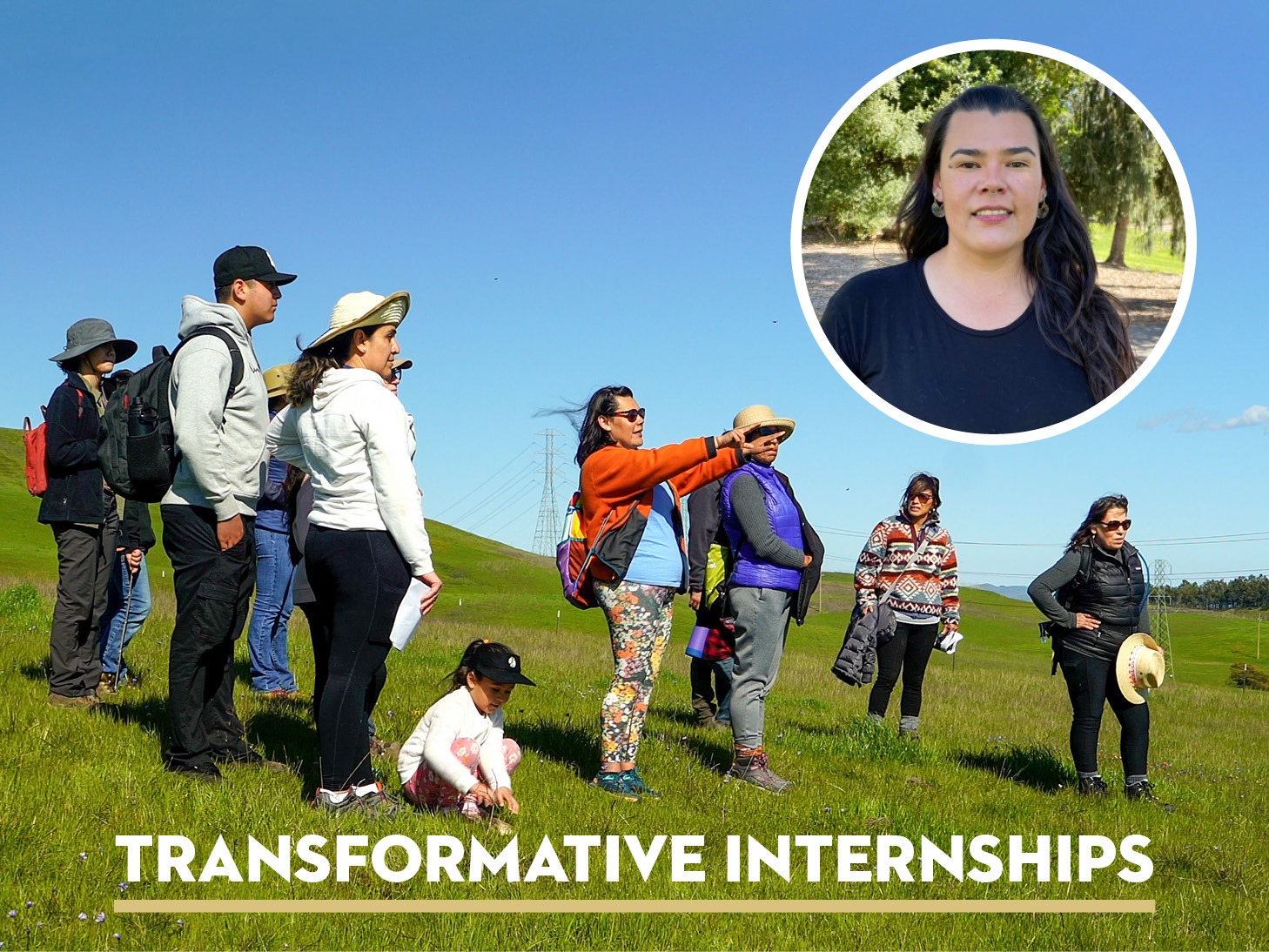
Growing up on the beaches of Orange County, Tania Delgado, our bilingual outings guide, cannot recall a time when she didn’t love or appreciate nature. She attributes this to her mother’s garden, and the ways her mother treated plants as sentient beings showing respect to all living things around her. Her love started with sandy toes at the local surfing beaches but grew as she explored the diversity of plants and wildlife in more rugged destinations like the Ortega and Silverado Canyons just an hour away.
Tania took her love of nature and headed north to Sonoma County to complete her Associate’s Degree in environmental studies on the path to become a park ranger. In a presentation about environmental career opportunities, Corby Hines, former outings guide with Sonoma Land Trust, made a presentation in her class about the internship program at Sonoma Land Trust and Tania decided to apply. Interrupted by Covid-19 which paused the internship program midstream, it wasn’t until Tania transferred to Sonoma State University to pursue her B.A. in Geography, Environment, and Planning that she reconnected with the internship program and completed the training.
During her internship, Tania learned about the biodiversity within Sonoma County and discussed what it meant to be located in a biodiversity hotspot. She shared, “Biodiversity is a textbook idea brought to life when you are on the land,” adding that she “enjoyed meeting others who shared my passion to care for the land.”
Tania’s training introduced her to the extensive conservation work Sonoma Land Trust was involved with and filled her with knowledge about conservation easements and the numerous deciding factors that influenced land and water restoration projects they designed. This new information paired with her college studies brought to life career paths in land conservation she hadn’t been exposed of before and interested her more than her initial plan of becoming a park ranger.
As college graduation approached, Tania knew she wanted to be in nature as much as possible doing community programs. By this time, she had been working as a retail manager for about seven years and for her, it was a means to an end, a way to pay for school and develop hard skills to carry with her into the future. However, she knew she wanted to be doing something that could positively impact in her community and connect to what she was most passionate about – land conversation.
Often there are times in life when the stars align and for Tania, the bilingual outings guide position opened just as she was stepping out with her new degree – and so she applied and this story has a happy ending.
That was almost a year ago and today, Tania enjoys leading public outings including our Familias al Aire Libre, introducing families to conservation concepts and our preserves for the first time. “I enjoy those moments when the families understand the importance of the land, make connections with nature and the environment, and depart feeling more connected to the world around them,” she shared. “There is a high percentage of returning participants at the Familias al Aire Libre outings which allows me to build deeper relationships as we explore new locations together each month.”
For any young person interested in pursuing environmental science or conservation as a career, Tania suggests completing as many internships as possible before applying for a job, “Internships can help rule out careers you thought you wanted and can also steer you toward a more fulfilling direction you may not have known about.”
If you or a college student you know is interested in an outings internship, applications are being accepted now for the 2023-2024 school year. Over the course of the 9-month internship, students participate in 20 outings, learning how to lead groups in the outdoors and educate the public about land conservation. A stipend and school credit are offered, as well as training and certification in first aid and CPR. For more information, visit https://sonomalandtrust.org/career-center or send a letter of interest to intern@sonomalandtrust.org
Do your own research – how teens are getting hands-on experience in nature’s laboratory
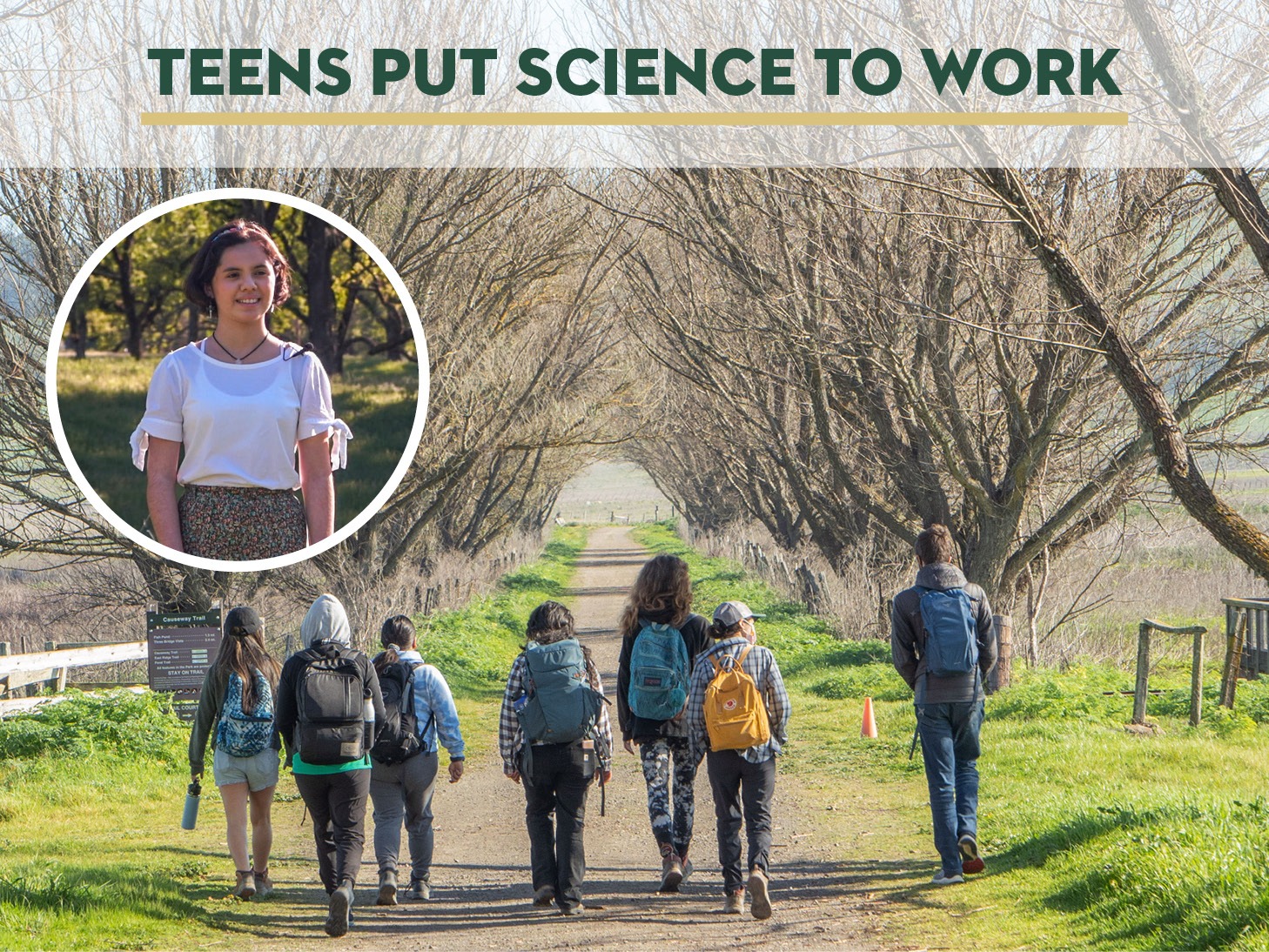
Research has shown that surroundings can dramatically affect a student’s connection with a given subject and that an engaged learning environment increases their attention and focus. Positive surroundings have been proven to also promote meaningful learning experiences, encourage higher levels of performance, and motivate students to practice higher-level critical thinking skills. And when those surroundings are in nature, they bring with them something that is surprising and vitally important: a sense of happiness.
Sonoma Land Trust provides environmental education opportunities for kids and teens through in-person and on-line programs throughout the year. Initiated in 2, the Conservation Council is an equity-based conservation science and youth-development program for high school students. The initial launch took place during the lock-down period of Covid-19 and was the only in-person, outdoor programming we were able to offer during that time. Over a 9-month period, participants work with educators, conservationists, scientists, and alongside their peers to conduct research, learn about conservation efforts, visit preserves, and gain outdoor and leadership skills.
We recently sat down with Mar Rivas, a Conservation Council program graduate, to learn about her experience with the program. In 2017, Mar’s family lost their home in the devastating Tubbs Fire that swept through the Coffey Park neighborhood in Santa Rosa. Like so many, they lost everything in minutes and found themselves displaced. Following the fire, Mar and her family moved from apartment to apartment, and although it has eased, she still experiences recurring anxiety during fire season.
Mar shared with us how the conservation education program, which she participated in the years following the fire during her junior and senior years of high school, has impacted her understanding of wildfire and how she’s bringing these newfound skills along with her into the next chapter of her life – college.
Q: What was your interest in nature before joining the Conservation Council (CC)?
A: I liked being outdoors. With the pandemic I didn’t have a specific reason or place to spend time outdoors since I lived in an apartment with no backyard and in a neighborhood that didn’t have a park. The Conservation Council gave me access and a reason to be outdoors.
Q: How did being a member of the Conservation Council affect your interests?
A: Before participating in the CC, I had written research papers from other sources but had never done the actual research myself. In the program, I learned about the different research methods, like how to set-up and collect data using wildlife cameras, which wouldn’t have been available to me without this program. It demystified the process of scientific research and has made the process more feasible for me to include in my future studies. The data analysis part was daunting at first, how it would be done, but then by completing analytical tasks, it became easier and fascinating.
Having an example of a team working together on a research paper was something else I gained from being on the Conservation Council. I wouldn’t have had the goals or aspirations to want to do research or have the clarity that it’s something I can do. Now, I’m interested in researching migration, racism and disposition, the social aspects of the topics I am currently studying.
Q: How did your climate research into wildfire and urban heat islands affect you?
A: Learning about wildfire, and fire ecology, has helped ease some of my anxiety surrounding wildfire season. I learned some trees need fire to reproduce and I realized that fire can be helpful and beneficial and not just destructive as it was during the Tubbs Fire. I still have anxiety it will happen again, but learning how fire can be a tool for lessening the danger of a major fire, and prevent a disastrous fire event from happening again, is important so no one else has to live through what I did.
The introduction to urban heat islands educated me about the type of area I lived in. When talking to friends, we would compare where we lMost of us live in heat islands, in towns that lack parks and trees, and only one friend who lived outside of town had access to nature. But the tradeoff was that they didn’t have access to stores, schools, and businesses nearby.
Having a separation between us and nature is detrimental. We are nature. Having more parks and open spaces would make a difference to our health and wellbeing and protect us from the worst effects of climate change.
Q: What was the most impactful part of being on the Conservation Council?
A: Building community and access to natural spaces for learning and recreation. Since my first year was during the height of the pandemic, the Conservation Council gave me an opportunity to get outside and visit places I wouldn’t necessarily have had access to. It also created a community with participants, which was especially important during a time many of us were feeling isolated. During my first year, we were really focused and committed to completing our research projects, which gave us a chance to be with others. In the second year, coming out of the pandemic, we came together but in a different way, and did our research with closer interactions and stronger relationships.
The Conservation Council was also a valuable and unique experience to be in nature and with like-minded individuals. It was a diverse group not usually represented in these types of spaces.
Q: How did your work on the Conservation Council influence your post-high school plans?
A: I always knew I wanted to go to college. In my second year on the Conservation Council, with some prompting and help with the applications from Mirella Ramos (the bilingual youth program manager at Sonoma Land Trust), I applied to U.C. Berkeley, U.C. Davis, and U.C. Santa Cruz, and was accepted by all three of them! Through that application process, I also learned about the cost of college, which informed my decision to not attend a four-year college just yet, but to first complete a few semesters at the Santa Rosa Junior College. The Conservation Council and Sonoma Land Trust have shown me that I don’t have to limit myself and can explore a variety of education paths. I have a lot of broad interests besides equal access to the outdoors and conservation. Because of the research I performed with the Conservation Council, I qualified to apply to a research program at Cornell University which I attribute to my experience with Sonoma Land Trust. I wouldn’t have thought to apply if it wasn’t for the exposure to this experience and the confidence I gained by doing the work myself.
Q: What advice would you give a young person interested in learning more about the environment?
A: To apply! The Conservation Council is a unique and rewarding experience! There aren’t many programs where you can do research and get paid a stipend. Applicants that live in an area lacking access to the outdoors are prioritized. If you have any interest in the sciences or want to be involved, you should apply. Even if you just like being outside, you should apply because you will absolutely grow as a person as you learn.
Applications for the next Conservation Council will open in mid-August. To receive a notification for our next application period, sign up for our youth email list on our webpage (scroll to the bottom): https://sonomalandtrust.org/conservation-council/
If you have any questions about the Conservation Council, or our other youth programs, contact us at youthprograms@sonomalandtrust.org or at (707) 324-3525.
My Reasons Why
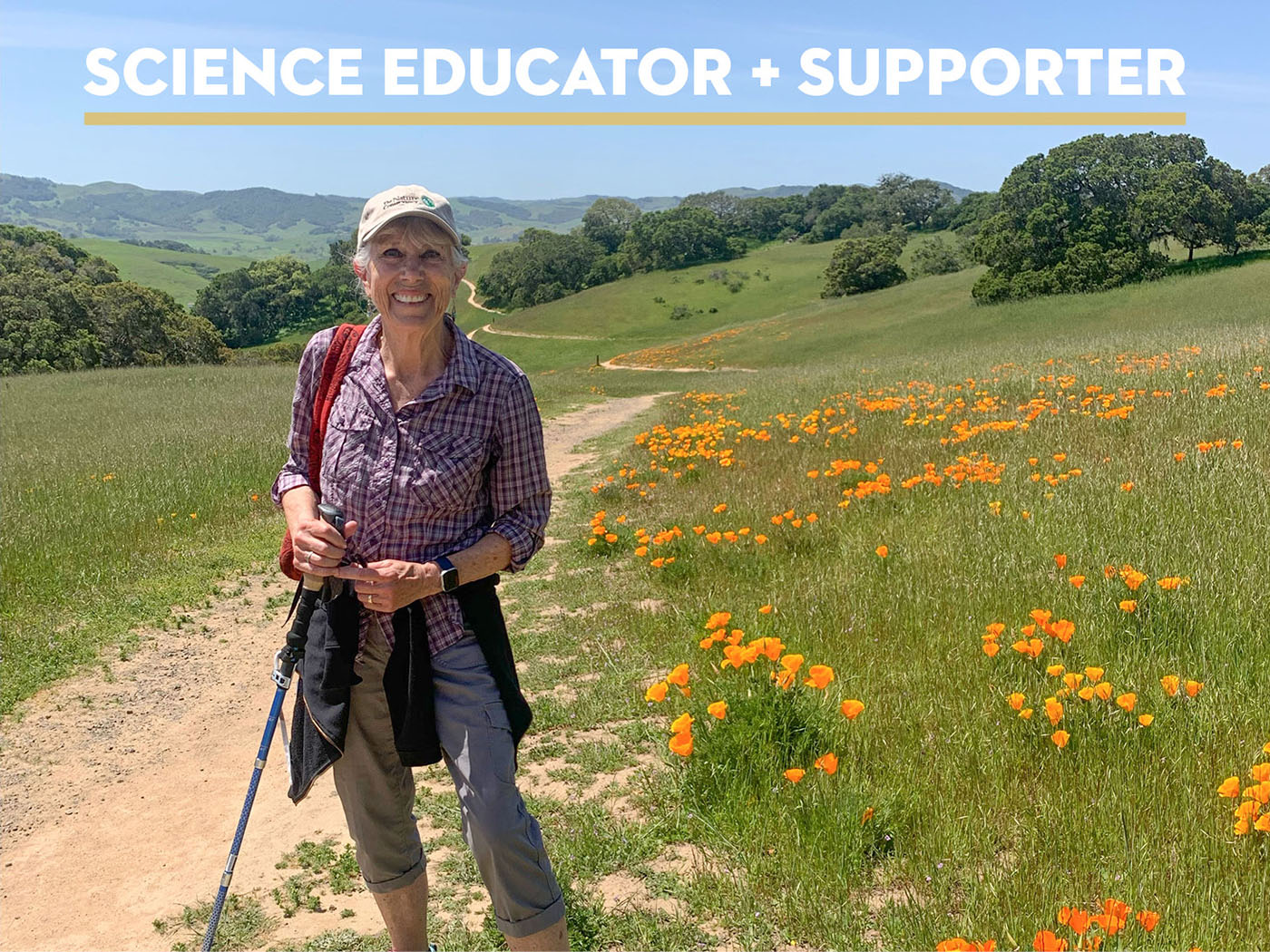
Every morning, rain or shine, I start off with a walk to clear my mind, set the tone for the day, and yes – make my Apple Watch proud of me. Luckily, I can easily find a quiet place to walk, a bit of open space to explore, and a place to connect with nature. That gives me a calming balance to handle whatever stresses lay ahead.
Growing up, I probably used a similar technique.
Fight with my big sister? Go climb a tree.
Exam-time overload? Head to the ocean.
Nature always had the answer to life’s problems.
Appreciation of, and respect for the environment was a big part of my science teaching career and I have seen firsthand both the excitement that nature can provide to students, as well as its calming effect. Despite the current all-engulfing attention to cell phones, I am convinced that 20 years from now, positive childhood memories will still zero in on times spent with friends and families outdoors.
Sonoma Land Trust is creating some of those memories: discovering what lives in the mud at Bay Camp, a family hike on one of our preserves, or a picnic in a new local park. Preserving Nature Nearby is a major focus of the Land Trust’s conservation efforts – ensuring equitable access to nature through parks and open space for everyone regardless of who you are or where you live. That is really important to me, as is the Conservation Council program, through which teens directly engage in conservation research and learn about potential career opportunities – taking action to make a difference.
That is what Sonoma Land Trust is all about – finding nature-based solutions to tackle the impacts of climate change and protect essential lands, waters, and threatened species. During the past few weeks, local headlines have featured major accomplishments of Sonoma Land Trust working with community partners: the acquisition of 174 acres of lush meadows and vernal pools; securing 750 acres of the Sonoma Developmental Center property as open space; the expanded protection of watersheds and wetlands as part of proposed solutions to the floods on Highway 37; and the Land Trust’s first large-scale urban project—Santa Rosa’s Southeast Greenway.
Sonoma Land Trust is investing in nature, the community, and our future. It feels great to support that investment. -Judy Scotchmoor, board member, donor, and major cheerleader of Sonoma Land Trust
Events
Language of the Land: A Plan for Conservation
May 25, 7-8:30pm
Join Eamon O’Byrne, John McCaull, and Neal Ramus for the unveiling of Sonoma Land Trust’s strategic plan which outlines our goals for the next five years. Highlighting three of our current conservation projects – Sonoma Mountain Vernal Pools, McCormick Ranch, and the Santa Rosa Southeast Greenway – they will demonstrate how our plans and goals are realized. Learn how these projects address our mission to protect biodiversity, fresh water, climate resilience, and provide access to nature, plus an understanding of how our plan contributes to the bigger picture of land conservation in Sonoma County.
Free Public Hikes in Partnership with Sonoma County Ag + Open Space
There is no charge for these events, which are made possible by the voters of Sonoma County who fund the work of Ag + Open Space with a quarter-cent sales tax.
Estos eventos son gratuitos y son posibles gracias a los votantes del condado de Sonoma, que financian la labor de Ag + Open Space con un impuesto sobre las ventas de un cuarto de céntimo.
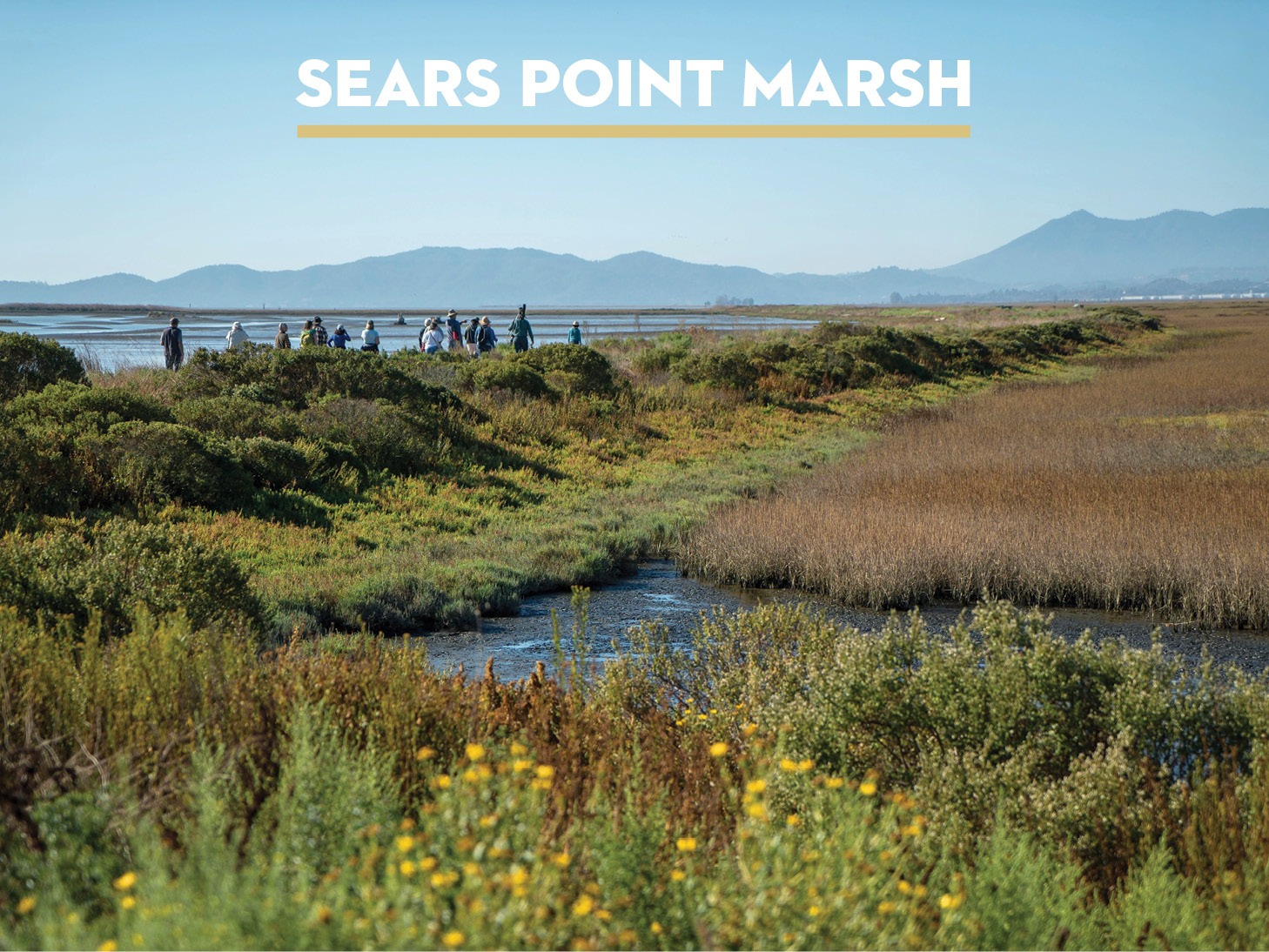
Sears Point Marsh Walk
Saturday, May 6, 10am–12pm
Join Sonoma Land Trust and Ag + Open Space for a leisurely walk on the Dickson Trail at the San Pablo Bay National Wildlife Refuge. We’ll observe the current tidal marsh restoration area at the former Dickson Ranch in comparison to the older tidal marsh restoration at the Sonoma Baylands as we walk along the levee trail that separates them.
Level: Gentle
Sears Point caminata de la marisma
Sábado, 2 de mayo, 10am –12pm
Acompáñe a Sonoma Land Trust y Ag + Open Space en un paseo tranquilo por el sendero Dickson en el Refugio Nacional de Vida Silvestre de la Bahía de San Pablo. Observaremos la zona actual de restauración de marismas mareales en el antiguo rancho Dickson en comparación con la restauración de marismas mareales más antigua en Sonoma Baylands mientras caminamos por el sendero del dique que las separa.
Nivel: Suave
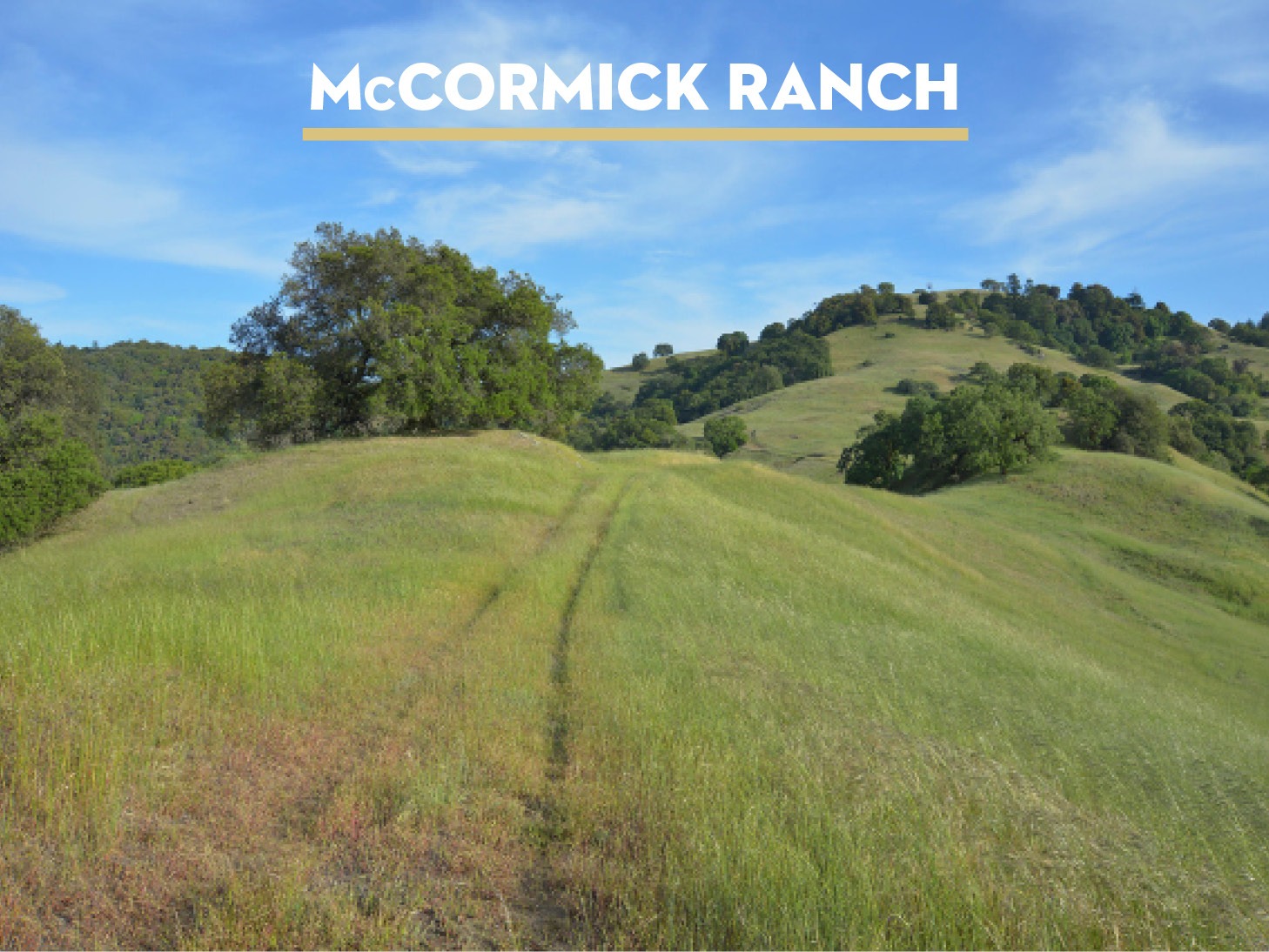
McCormick Ranch Hike
Sunday, May 7, 10am–2:30pm
This 650-acre historic ranch straddles the ridgeline of the Mayacamas Mountains with spectacular views of the coast, San Francisco Bay and nearby peaks. Join Sonoma Land Trust and Ag + Open Space for a walk on this land and learn about the Land Trust‘s plans to add this property to one of our region’s premier wilderness parks, ensuring protected wildlife habitat and publicly accessible trails into the future. This single acquisition will create the largest Bay Area Ridge Trail system in Sonoma-Napa counties and support thru-hiking and overnight experiences.
This hike is approximately three miles long with one very steep stretch with an elevation gain of 300 feet.
Level: Moderate
Caminata por McCormick Ranch
Domingo, 7 de mayo, 10am–2:30pm
Este rancho histórico de 650 acres se extiende a lo largo de la línea de cresta de las montañas Mayacamas con vistas espectaculares de la costa, la bahía de San Francisco y los picos cercanos. Acompáñe a Sonoma Land Trust y Ag + Open Space para una caminata en esta tierra y aprender sobre los planes de Land Trust para añadir esta propiedad a uno de los parques naturales de nuestra región, asegurando un hábitat de vida silvestre protegido y con senderos accesibles al público en el futuro. Esta única adquisición creará el mayor sistema de senderos Bay Area Ridge Trail en los condados de Sonoma-Napa y permitirá realizar excursiones de acampar.
Esta ruta es aproximada de tres millas, con un tramo muy empinado y un desnivel de 300 pies.
Nivel: Moderada
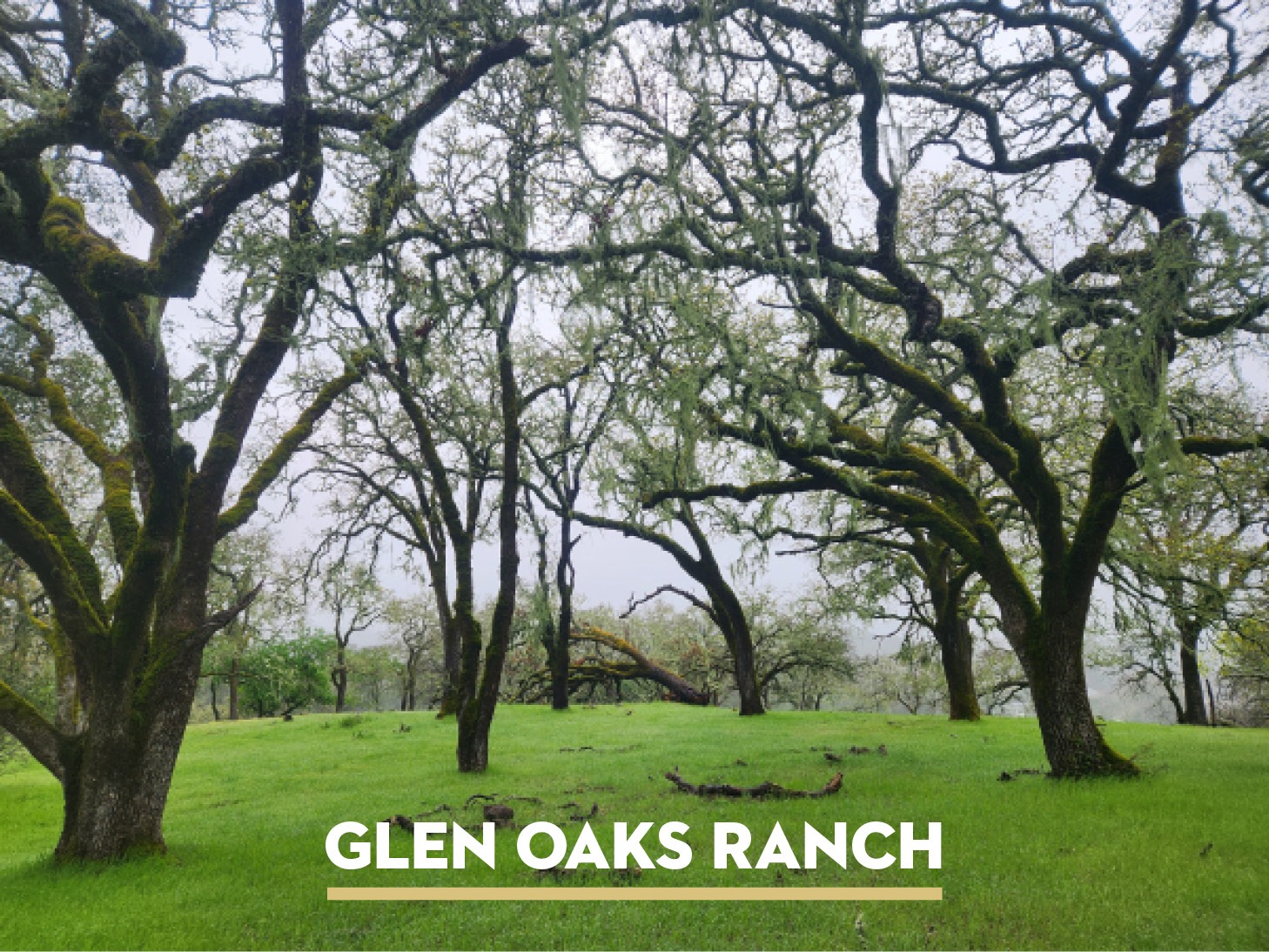
Glen Oaks Ranch Walk
Saturday, May 13, 10am–2pm
Join Sonoma Land Trust and Ag + Open Space for a hike at Glen Oaks Ranch — an historic ranch located in Sonoma Valley near Glen Ellen. We’ll take a look at the wildflowers, observe the regrowth post-2017 fires, and walk through an area that had a prescribed burn in the fall.
This 234-acre preserve was donated to Sonoma Land Trust in 2001. Sonoma County Ag + Open Space holds a conservation easement on this land, which designates three conservation zones — historic, agriculture and forever wild. This hike is approximately 3 miles with a 300-foot elevation gain.
Level: Moderate
Caminata por Glen Oaks Ranch
Sábado, 13 de mayo, 10am–2pm
Acompáñe a Sonoma Land Trust y Ag + Open Space para una caminata en Glen Oaks Ranch – un rancho histórico situado en el valle de Sonoma, cerca de Glen Ellen. Echaremos un vistazo a las flores silvestres, observaremos el recrecimiento después de los incendios de 2017 y caminaremos por una zona en la que se realizó una quema prescrita en otoño.
Esta reserva de 234 acres fue donada a Sonoma Land Trust en 2001. Sonoma County Ag + Open Space posee una servidumbre de conservación sobre esta tierra, que designa tres zonas de conservación: histórica, agrícola y silvestre para siempre. Esta caminata es de aproximadamente 3 millas con un desnivel de 300 pies.
Nivel: Moderada
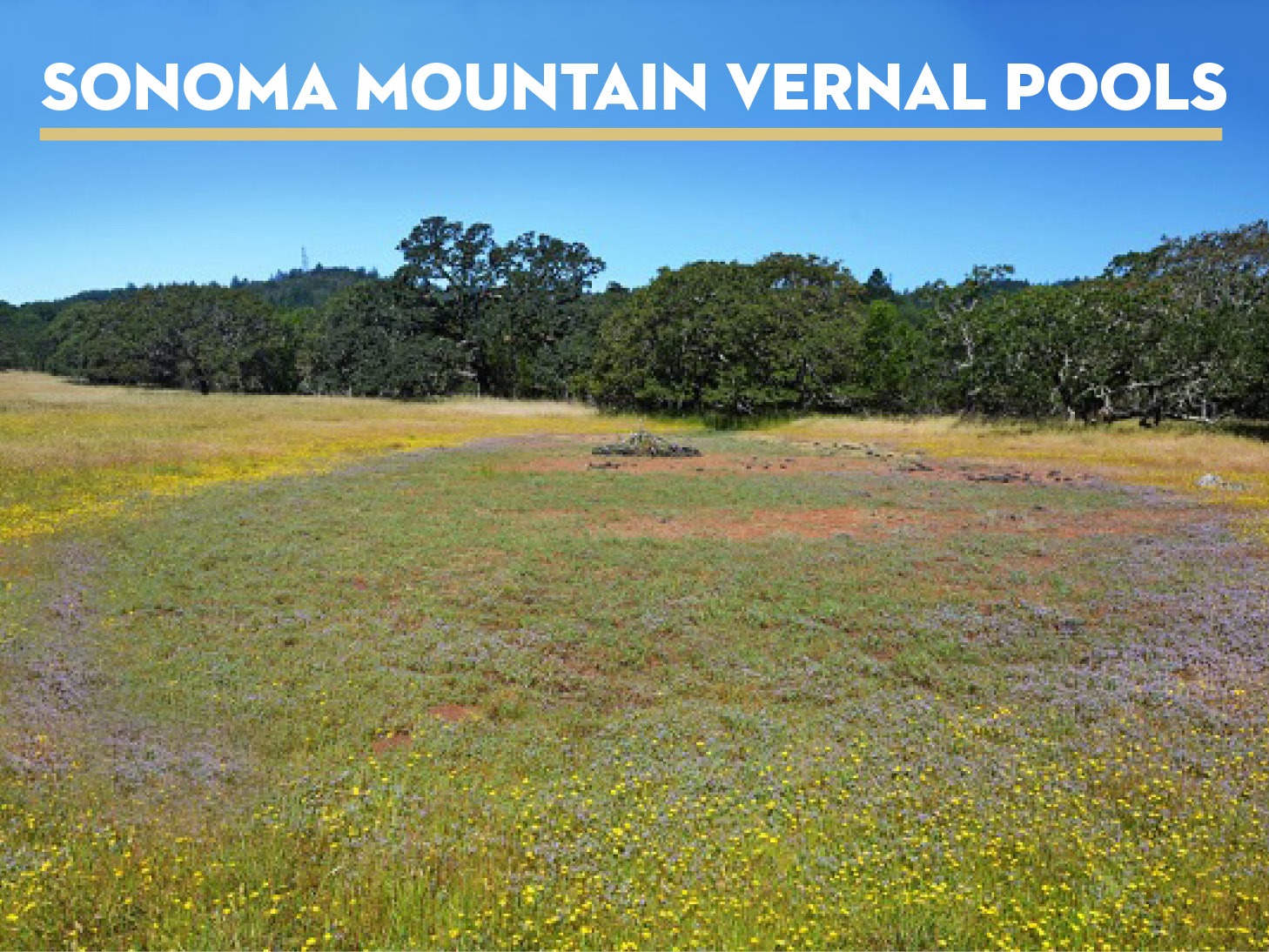
Sonoma Mountain Vernal Pools
Sunday, May 14, 10am–1pm
Sunday, May 21, 10am–1pm
Join Sonoma Land Trust and Sonoma County Ag + Open Space for a walk on the newly acquired Sonoma Mountain Vernal Pools property. This 174-acre preserve protects rare and threatened plant species and conserves a significant portion of a wildlife corridor. We will walk through the oak woodlands and meadows to see the vernal pools and enjoy the beauty of this ecological preserve.
The Sonoma Mountain Vernal Pools property was acquired by Sonoma Land Trust in March of 2023. As a partner in the project, Sonoma County Ag + Open Space holds a conservation easement on the property. Additional funding partners include the Gordon and Betty Moore Foundation, the State Coastal Conservancy, and the California Natural Resources Agency. This land protection will ensure the ongoing health of the property’s natural features, including two rare vernal pools, mature oak woodlands, intact grasslands, and portions of Yulupa Creek.
Level: Gentle to Moderate
Sonoma Mountain Vernal Pools
Domingo, 14 de mayo, 10am–1pm
Domingo, 21 de mayo, 10am–1pm
Acompáñe a Sonoma Land Trust y a Sonoma County Ag + Open Space para una caminata por la propiedad recién adquirida Sonoma Mountain Vernal Pools. Esta reserva de 174 acres protege especies de plantas raras y amenazadas y conserva una parte importante de un corredor de vida silvestre. Caminaremos por los robledales y praderas para ver las charcas vernales y disfrutar de la belleza de esta reserva ecológica.
La propiedad Sonoma Mountain Vernal Pools fue adquirida por Sonoma Land Trust en marzo de 2023. Como socio del proyecto, Sonoma County Ag + Open Space posee una servidumbre de conservación sobre la propiedad. Otros socios financiadores son Gordon and Betty Moore Foundation, State Coastal Conservancy y California Natural Resources Agency. Esta protección de la tierra garantizará la salud permanente de las características naturales de la propiedad, incluyendo dos charcas vernales raras, bosques de robles maduros, praderas intactas y partes del arroyo Yulupa.
Nivel: Suave a moderada
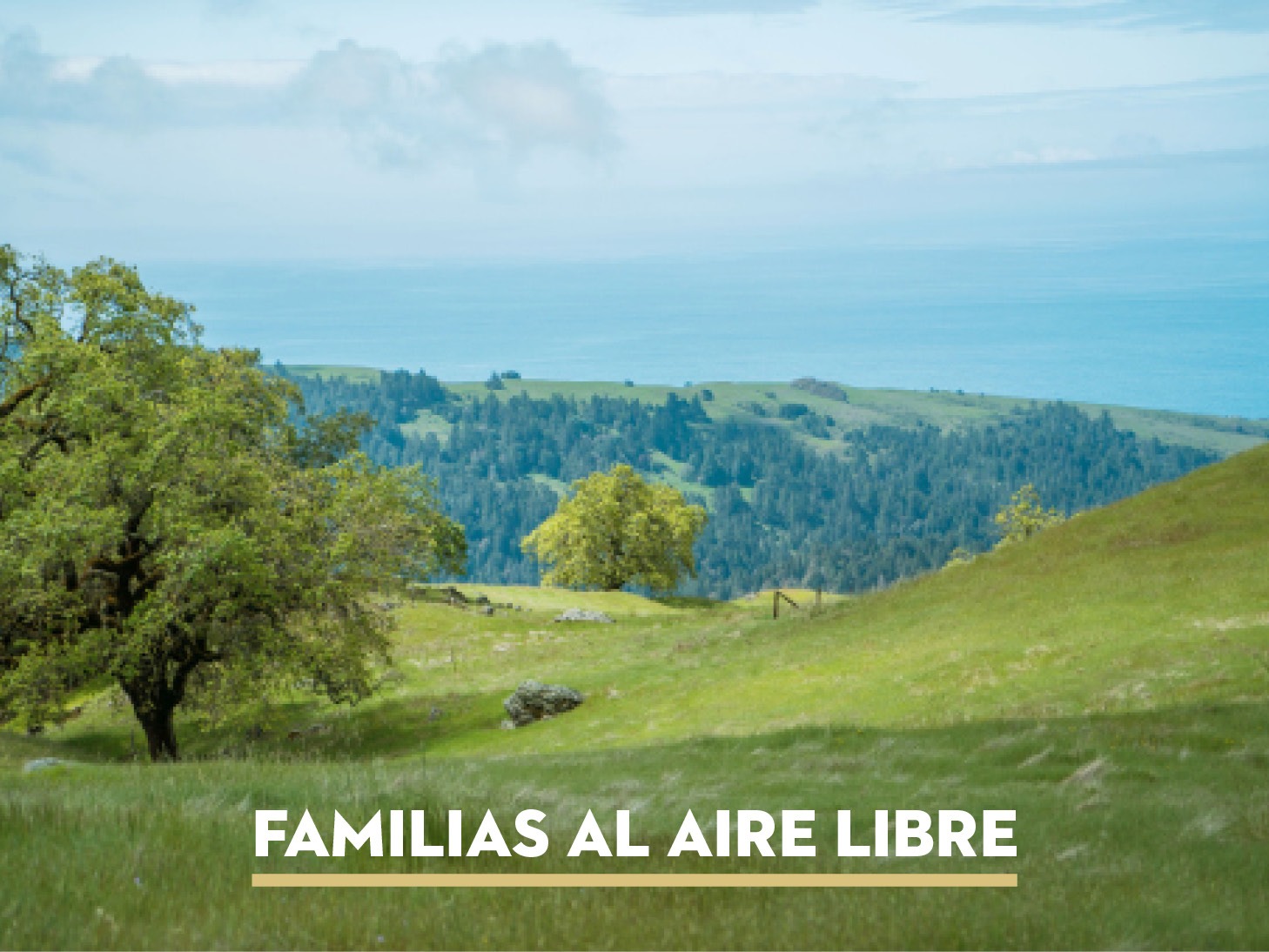
Families Outdoors
Saturday, May 20, 10am–3pm
This month’s Familias al Aire Libre adventure will take us to the top of Pole Mountain! Bring your family and enjoy a Spanish-led walk with Sonoma Land Trust and Ag + Open Space up the last mile to the top of Pole Mountain. We’ll enjoy panoramic views of the landscape from the highest point on the Sonoma Coast.
Familias al Aire Libre
Sábado, 20 de mayo, 10am–3pm
La aventura de Familias al Aire Libre de este mes nos llevará a la cima del Pole Mountain. Trae a tu familia y disfruta de un paseo guiado en español con Sonoma Land Trust y Ag + Open Space en la última milla de la cima de Pole Mountain. Disfrutaremos de vistas panorámicas del paisaje desde el punto más alto de la costa de Sonoma.
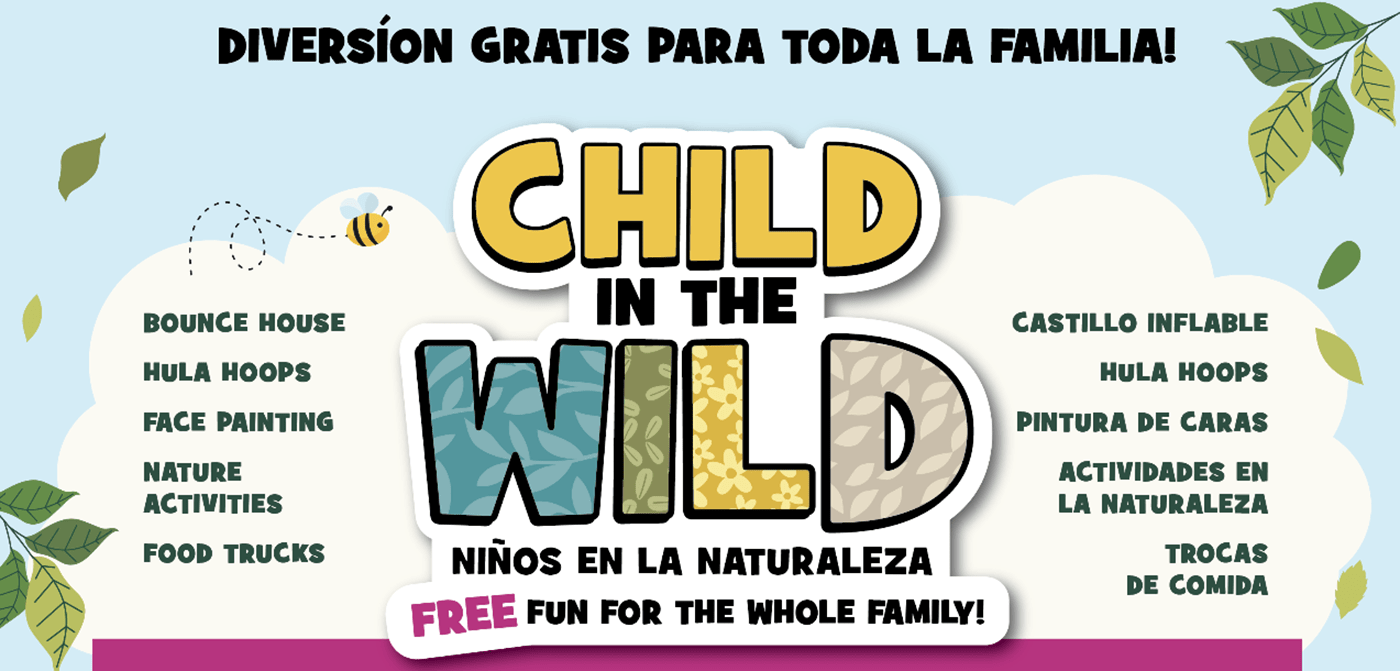
Child in the Wild / Niños en la naturaleza
June 4
Join us for a family friendly event Sunday, June 4, 2023 at Howarth Park in Santa Rosa from 12pm-5pm. Live music, crafts, bounce house, food trucks, and more!
Recommendations
- Book: The Nature Fix: why nature makes us happier, healthier, and more creative by Florence Williams – http://www.florencewilliams.com/the-nature-fix
- Podcast: Jane Goodall’s Hopecast Series: https://janegoodall.ca/hope-inspiration/hopecast/
- Video: For Kids: An Adventure into the Salt Marsh Ecosystem – https://www.youtube.com/watch?v=BeA91bK0r94&t=3s
- TED Talk: Nature is everywhere – we just need to learn to see it – https://www.ted.com/talk/emma_marris_nature_is_everywhere_we_just_need_to_learn_to_see_it
- App: PeakVisor https://peakvisor.com/
